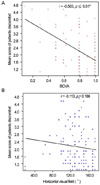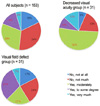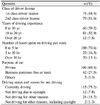Abstract
Purpose
This study examines driving behaviors among patients treated for chronic ophthalmologic disorders and the effects of visual acuity and visual field on driving performance.
Methods
A 15-item survey was given to 153 patients treated for chronic ophthalmologic disorders including diabetic retinopathy, glaucoma, retinal vessel occlusions, and senile macular degeneration. Six items questioned the patient's discomfort based on a five-point scale according to different driving conditions and one item involved a self-assessment of driving problems. Results were compared with the best corrected visual acuity (BCVA) and visual fields of the patients.
Results
In total, 16.2% of first-class drivers and 24.1% of second-class drivers rated below the evaluation standards of the driving license aptitude test. Overall, 82.6% of the patients continued to drive, while 7.8% renounced driving due to decreased visual acuity. Patient discomfort was significantly correlated with visual acuity (r = -0.503, p ≤ 0.01). Among the patients scoring below the evaluation standards, 74.2% responded that their visual acuity had become a problem while driving.
Figures and Tables
Figure 1
Scatter plots representing the correlation between mean scores of patients' discomfort with visual acuity (panel A: above) and horizontal visual field (panel B: below). BCVA = best corrected visual acuity. *Tested by Pearson's correlation coefficient.

Figure 2
Patients' response indicating the level of hindrance poor eyesight had on driving. These figures were created using patients' response from questionnaire item 15, which asked whether their eyesight (including visual field) hindered their driving. The response categories were measured using a 5-point ordinal scale: (1) No, not at all (dark blue), (2) No, not much (red), (3) Yes, moderately (green), (4) Yes, to some degree (purple), and (5) Yes, very much (light blue).

References
1. Rockwell TH. Forbes TW, editor. Skills, judgement and information acquisition during driving. Human Factors in Highway Traffic Safety Research. 1972. New York: WileyInterscience;133–164.
2. Owsley C, McGwin G Jr. Vision impairment and driving. Surv Ophthalmol. 1999. 43:535–550.
3. Gibson JM, Rosenthal AR, Lavery J. A study of the prevalence of eye disease in the elderly in an English community. Trans Ophthalmol Soc U K. 1985. 104(Pt 2):196–203.
4. Wood JM. Age and visual impairment decrease driving performance as measured on a closed-road circuit. Hum Factors. 2002. 44:482–494.
5. Kim YD, Park SC, Kim DH. Epidemiological analysis and study of social welfare of low vision patients. J Korean Ophthalmol Soc. 2007. 48:111–116.
6. Burg A. The relationship between vision test scores and driving record: General findings (Report 67-24). 1967. Los Angeles: Department of Engineering, University of California.
7. Decina LE, Staplin L. Retrospective evaluation of alternative vision screening criteria for older and younger drivers. Accid Anal Prev. 1993. 25:267–275.
8. Johnson CA, Keltner JL. Incidence of visual field loss in 20,000 eyes and its relationship to driving performance. Arch Ophthalmol. 1983. 101:371–375.
9. Lovsund P, Hedin A, Törnros J. Effects on driving performance of visual field defects: a driving simulator study. Accid Anal Prev. 1991. 23:331–342.
10. McCloskey LW, Koepsell TD, Wolf ME, Bunchner DM. Motor vehicle collision injuries and sensory impairments of older drivers. Age Ageing. 1994. 23:267–273.
11. Watts P, O'Duffy D, Riddel C, et al. Can I drive after those drops, doctor? Eye (Lond). 1998. 12:963–966.




 PDF
PDF ePub
ePub Citation
Citation Print
Print







 XML Download
XML Download